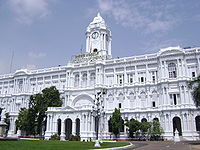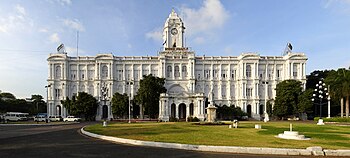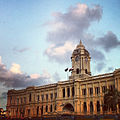Ripon Building
| Ripon Building | |
|---|---|
 | |
 | |
| Alternative names | Greater Chennai Corporation Headquarters |
| General information | |
| Type | Government Buildings |
| Architectural style | Neoclassical |
| Town or city | Chennai |
| Country | |
| Coordinates | 13°04′54″N 80°16′18″E / 13.0817°N 80.2716°E |
| Current tenants | Seat of the Greater Chennai Corporation |
| Construction started | 1909 |
| Completed | 1913 |
| Cost | ₹750,000 (in 1913) |
| Owner | Government of Tamil Nadu |
The Ripon Building is the seat and headquarters of the Greater Chennai Corporation in Chennai, Tamil Nadu. It is an example of neoclassical architecture, a combination of Ionic and Corinthian styles. The Ripon Building is an all-white structure and is located near the Dr. M.G.R Railway Station.
History[edit]
Commissioned in the year 1909, Ripon Building was designed by G.T.S. Harris. The foundation stone was laid by Lord Minto, Viceroy of India, on December 11, 1909.[1] It was built by Loganatha Mudaliar, and took four years to build at a cost of 750,000, including a sum of 550,000 paid to Mudaliar.[citation needed] The Ripon building was named after Lord Ripon, Governor-General of British India and the Father of local self-government. Earl of Minto, the then Viceroy and Governor General of India laid the foundation on 12 December 1909. The Municipal Corporation of Madras, after functioning from several other places including Errabalu Chetty Street, settled at Ripon building in 1913, with P. L. Moore as the President of the Municipal Corporation at the time of the inauguration. The inaugural function was attended by over 3,000 of the city's elites.
Building details[edit]
The building is rectangular, 85 metres (279 ft) long and 32 metres (105 ft) wide, with a 43 metres (141 ft) high central tower containing a clock 2.5 m (8.2 ft) in diameter.[citation needed] The first of its three floors has approximately 2,800 m2 (30,139 sq ft) of space.[citation needed] The walls were constructed with stock bricks, set and plastered with lime mortar and the roof is supported with teak wood joists.[citation needed] The original flooring of the ground floor was Cuddapah Slate that has been replaced with marble.[citation needed] One of the main attractions of the building is the Westminster Quarter chiming clock.[citation needed] This was installed by Oakes and Co. in 1913. The clock has a mechanical key system, which is wound every day. There are four bells, which were cast by Gillet and Johnston in 1913.[citation needed]
Annexe building[edit]
To the rear of the main building is an annexe building (American English: "annex"), inaugurated in September 2015 under the name "Amma Maaligai".[2] All departments of the Chennai Corporation, except the offices of the Mayor and Commissioner, function from the annexe building. The offices of the Mayor and the Commissioner offices are in the main building. The annexe building was constructed at a cost of ₹ 230 million and has a built-up area of 150,000 sq. ft. and a parking space for 50 cars and 150 motorcycles. The building, built with aspects of a green building, could accommodate about 1,000 officials. The building also features a 500-seat auditorium, a 100-seat conference hall and 70 toilets with facilities for disabled people. The building has been able to reduce energy consumption by 20 percent by means of a water-cooled air-conditioning system and heat-reflective tiles on the roof. The building has been designed in a post-modern style, with some elements of traditional architecture. Some design elements would suit the colonial-style architecture of the Ripon Buildings.[3]
Restoration[edit]
In 2012, a massive renovation was initiated at a cost of ₹77 million under the Jawaharlal Nehru National Urban Renewal Mission (JNNURM), to preserve the building's original grandeur. Under this, an annexe building measuring 12,540 sq m will be constructed alongside the main structure to house all the departments of the Corporation, and all structures in the premises that do not blend in with the main structure aesthetically will be demolished in June 2013 when the annexe building is completed. The annexe building, with an auditorium to seat 500 persons, will be built in a contemporary and post-modern style, highlighting with elements of regional architecture, to blend with the Indo-Saracenic style of the main building. The main building is also being renovated under the process with the use of lime mortar for plastering. It is the first heritage building in the country to have received funds from JNNURM for renovation.[4]
Gallery[edit]
See also[edit]
- Architecture of Chennai
- Heritage structures in Chennai
- List of Tamil Nadu Government Estates, Complexes, Buildings and Structures
References[edit]
- ↑ Centenary of a civic landmark // Madras Heritage and Carnatic Music
- ↑ Xavier Lopez, Aloysius (14 September 2015). "'Amma maaligai' to be inaugurated tomorrow". The Hindu. Chennai. Retrieved 17 February 2020.
- ↑ Xavier Lopez, Aloysius (1 August 2014). "'Amma Maaligai' emerges as hub". The Hindu. Chennai. Retrieved 9 August 2014.
- ↑ Xavier Lopez, Aloysius (9 January 2013). "Eyesores on Ripon Buildings premises to go". The Hindu. Chennai. Retrieved 9 January 2013.
- Articles with unsourced statements from March 2020
- Articles with unsourced statements from May 2018
- Office buildings in Chennai
- Tourist attractions in Chennai
- Municipal buildings in India
- Buildings and structures completed in 1913
- Government of Chennai
- Indo-Saracenic Revival architecture
- Heritage sites in Chennai







